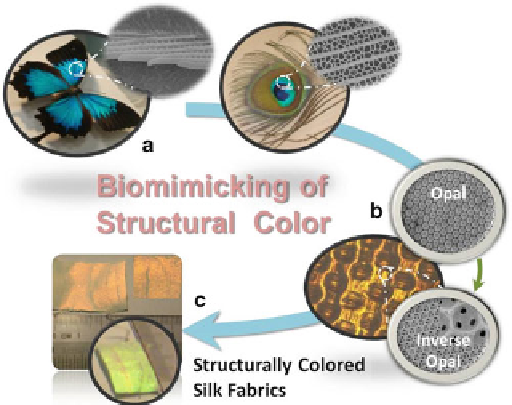Biomedical Engineering Reference
In-Depth Information
Fig. 7.15
Biomimetics of structural colors on silk fabrics. (
a
) The structural colors of butterfly
(
Papilio ullysess
butterfly) and peacock feather. (
b
) Fabrication of opal and inverse opal on silk
fabrics. Refer to Ref. [
140
] for the details of fabrication. (
c
) Structurally colored silk fabrics.
Reprinted with permission from Ref. [
30
] © 2012 Wiley-VCH Verlag GmbH & Co
templates to replicate the nanostructures so as to obtain the optical properties.
Wa n g
et al.
examined the fine structure of the wing scale of a
Morpho peleides
butterfly and replicated the entire configuration by a uniform Al
2
O
3
coating through
a low-temperature atomic layer deposition (ALD) process [
149
]. An inverted
structure was achieved by removing the butterfly wing template at high temperature,
forming a polycrystalline Al
2
O
3
shell structure with precisely controlled thickness.
Other than the copy of the morphology of the structure, the optical property,
such as the existence of photonic band gap (PBG), was also inherited by the
alumina replica. Other replicating methods have also been employed to replicate
the structures of natural photonic materials, including conformal-evaporated-film-
by-rotation technique and soft lithography technique [
150
,
151
].
3D colloidal crystals with a PBG lying in the visible range are another option for
mimicking natural structural color. Inspired by natural photonic crystals (Fig.
7.15
),
researchers have fabricated colloidal crystals with tunable structural colors
[
152
-
158
]. One of the most commonly used techniques to fabricate colloidal
crystals is the evaporation-induced self-assemble method, which enables the
rapid production of highly ordered 3D colloidal crystals with face-center cubic
structure. In connection with this technology, the wettability can be adjusted by the
intrinsic roughness of colloidal crystals in combination with the tunable chemical
composition of latex surfaces while the band gaps can be tuned by changing the
size of the colloidal spheres.
Although colloidal crystals can be fabricated easily and are of wide potential
applications, they are weak in the mechanical properties and dispersible in water.

